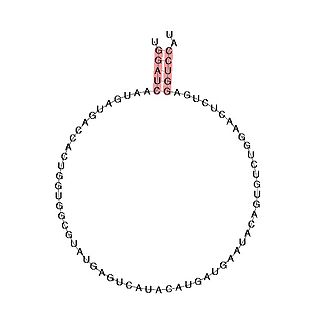Related Research Articles
Genomic imprinting is an epigenetic phenomenon that causes genes to be expressed in a parent-of-origin-specific manner. Genes however, can also be partially imprinted. Partial imprinting happens when alleles from both parents are differently expressed rather than complete expression and complete suppression of one parents allele. Forms of genomic imprinting have been demonstrated in fungi, plants and animals. As of 2014, there are about 150 imprinted genes known in the mouse and about half that in humans. In 2019, 260 imprinted genes have been reported in mice and 228 in humans.
Polyadenylation is the addition of a poly(A) tail to a RNA transcript, typically a messenger RNA (mRNA). The poly(A) tail consists of multiple adenosine monophosphates; in other words, it is a stretch of RNA that has only adenine bases. In eukaryotes, polyadenylation is part of the process that produces mature mRNA for translation. In many bacteria, the poly(A) tail promotes degradation of the mRNA. It, therefore, forms part of the larger process of gene expression.
Small nucleolar RNAs (snoRNAs) are a class of small RNA molecules that primarily guide chemical modifications of other RNAs, mainly ribosomal RNAs, transfer RNAs and small nuclear RNAs. There are two main classes of snoRNA, the C/D box snoRNAs, which are associated with methylation, and the H/ACA box snoRNAs, which are associated with pseudouridylation. SnoRNAs are commonly referred to as guide RNAs but should not be confused with the guide RNAs that direct RNA editing in trypanosomes.

GNAS complex locus is a gene locus in humans. Its main product is the heterotrimeric G-protein alpha subunit Gs-α, a key component of G protein-coupled receptor-regulated adenylyl cyclase signal transduction pathways. GNAS stands for Guanine Nucleotide binding protein, Alpha Stimulating activity polypeptide.

SNORD115 is a non-coding RNA (ncRNA) molecule known as a small nucleolar RNA which usually functions in guiding the modification of other non-coding RNAs. This type of modifying RNA is usually located in the nucleolus of the eukaryotic cell which is a major site of snRNA biogenesis. HBII-52 refers to the human gene, whereas RBII-52 is used for the rat gene and MBII-52 is used for naming the mouse gene.

SNORD64 is a non-coding RNA (ncRNA) molecule which functions in the biogenesis (modification) of other small nuclear RNAs (snRNAs). This type of modifying RNA is located in the nucleolus of the eukaryotic cell which is a major site of snRNA biogenesis. It is known as a small nucleolar RNA (snoRNA) and also often referred to as a guide RNA.

Mesoderm-specific transcript homolog protein is a protein that in humans is encoded by the MEST gene.

Retrotransposon-derived protein PEG10 is a protein that in humans is encoded by the PEG10 gene.
KCNQ1 overlapping transcript 1, also known as KCNQ1OT1, is a long non-coding RNA gene found in the KCNQ1 locus. This locus consists of 8–10 protein-coding genes, specifically expressed from the maternal allele, and the paternally expressed non-coding RNA gene KCNQ1OT1. KCNQ1OT1 and KCNQ1 are imprinted genes and are part of an imprinting control region (ICR). Mitsuya identified that KCNQ1OT1 is an antisense transcript of KCNQ1. KCNQ1OT1 is a paternally expressed allele and KCNQ1 is a maternally expressed allele. KCNQ1OT1 is a nuclear, 91 kb transcript, found in close proximity to the nucleolus in certain cell types.

Long non-coding RNAs are a type of RNA, defined as being transcripts with lengths exceeding 200 nucleotides that are not translated into protein. This somewhat arbitrary limit distinguishes long ncRNAs from small non-coding RNAs such as microRNAs (miRNAs), small interfering RNAs (siRNAs), Piwi-interacting RNAs (piRNAs), small nucleolar RNAs (snoRNAs), and other short RNAs. Long intervening/intergenic noncoding RNAs (lincRNAs) are sequences of lncRNA which do not overlap protein-coding genes.
MEG3 is a maternally expressed, imprinted long non-coding RNA gene. At least 12 different isoforms of MEG3 are generated by alternative splicing. Expression of MEG3 is lost in cancer cells. It acts as a growth suppressor in tumour cells, and activates p53. A pituitary transcript variant has been associated with inhibited cell proliferation. Studies in mouse and sheep suggest that an upstream intergenic differentially methylated region (IG-DMR) regulates imprinting of the region. The expression profile in mouse of the co-regulated Meg3 and Dlk1 genes suggests a causative role in the pathologies found in uniparental disomy animals, characterized by defects in skeletal muscle maturation, bone formation, placenta size and organization and prenatal lethality. The sheep homolog is associated with the callipyge mutation which in heterozygous individuals affects a muscle-specific long-range control element located in the DLK1-GTL2 intergenic region and results in the callipyge muscular hypertrophy. The non-Mendelian inheritance pattern, known as polar overdominance, likely results from the combination of the cis-effect on the expression levels of genes in the DLK1-GTL2 imprinted domain, and trans interaction between the products of reciprocally imprinted genes.

Small nucleolar RNA SNORD113 is a small nucleolar RNA molecule which is located in the imprinted human 14q32 locus and may play a role in the evolution and/or mechanism of the epigenetic imprinting process.
MIAT, also known as RNCR2 or Gomafu, is a long non-coding RNA. Single nucleotide polymorphisms (SNPs) in MIAT are associated with a risk of myocardial infarction. It is expressed in neurons, and located in the nucleus. It plays a role in the regulation of retinal cell fate specification. Crea and collaborators have shown that MIAT is highly up-regulated in aggressive prostate cancer samples, raising the possibility that this gene plays a role in cancer progression.

In molecular biology, DiGeorge syndrome critical region gene 5 , also known as DGCR5, is a long non-coding RNA. In humans, it is located on chromosome 22q11, at the ADU breakpoint associated with DiGeorge syndrome. Its expression is regulated by the transcription factor REST.
In molecular biology, GNAS antisense RNA , also known as GNAS-AS1, is a long non-coding RNA.It is antisense to the GNAS gene. It is an imprinted gene, expressed only from the paternal allele, suggesting that it may have a role in suppression of the paternal NESP55 allele encoded by GNAS.
In molecular biology, MEST intronic transcript 1, antisense RNA, also known as MESTIT1 or PEG1-AS is a long non-coding RNA. It is an imprinted gene, which is paternally expressed. In humans, it is found on chromosome 7q32, imprinted genes on chromosome 7 are believed to be involved in Russell-Silver syndrome (RSS). However, it is believed that MESTIT1 is unlikely to cause Russell-Silver syndrome as there is a lack of mutations in this gene in Russell-Silver syndrome patients. MESTIT1 may regulate the expression of the MEST gene.
In molecular biology, MER1 repeat containing imprinted transcript 1, also known as MIMT1 is a long non-coding RNA. It is an imprinted gene, which is paternally expressed. Deletion of this gene is lethal in cattle, causing still births and abortions. It is lethal in 85% of individuals with the deletion, it is thought that incomplete silencing of maternally imprinted alleles allows some individuals with the deletion to survive.
In molecular biology, WT1 antisense RNA, also known as WT1-AS or WIT1, is a long non-coding RNA. In humans, it is found on chromosome 11 and is expressed in kidney. It is transcribed in the opposite direction to the WT1 gene. It is functionally imprinted in the human kidney, where only the paternal allele is expressed, but not in the foetal kidney.

UBE3A-ATS/Ube3a-ATS (human/mouse), otherwise known as ubiquitin ligase E3A-ATS, is the name for the antisense DNA strand that is transcribed as part of a larger transcript called LNCAT at the Ube3a locus. The Ube3a locus is imprinted and in the central nervous system expressed only from the maternal allele. Silencing of Ube3a on the paternal allele is thought to occur through the Ube3a-ATS part of LNCAT, since non-coding antisense transcripts are often found at imprinted loci. The deletion and/or mutation of Ube3a on the maternal chromosome causes Angelman Syndrome (AS) and Ube3a-ATS may prove to be an important aspect in finding a therapy for this disease. While in patients with AS the maternal Ube3a allele is inactive, the paternal allele is intact but epigenetically silenced. If unsilenced, the paternal allele could be a source of active Ube3a protein in AS patients. Therefore, understanding the mechanisms of how Ube3a-ATS might be involved in silencing the paternal Ube3a may lead to new therapies for AS. This possibility has been demonstrated by a recent study where the drug topotecan, administered to mice suffering from AS, activated expression of the paternal Ube3a gene by lowering the transcription of Ube3a-ATS.

Joomyeong Kim is a Russell Thompson, Jr. Family Professor of Biology at Louisiana State University. His research interests include genomic imprinting and epigenetics. Dr. Kim's laboratory is mainly involved in understanding the functions and regulatory mechanisms governing genes subject to genomic imprinting. Having previously characterized an imprinted domain located on proximal mouse chromosome 7/ human chromosome 19q13.4, his laboratory currently focuses on understanding regulatory mechanisms directing the mono-allelic expression of the seven imprinted genes in the cluster: Peg3, Usp29, Zfp264, APeg3 and Zim1, Zim2, Zim3. As a second project direction, his lab studies the function of the dominant gene in the cluster, Peg3, as a transcriptional regulator. Past projects in the Kim lab have included studying the epigenetic instability of imprinted genes during tumorigenesis, potential roles of AEBP2 as a PRC2 targeting protein and in neural crest cell development, as well as the DNA methylation of mouse and human retrotransposons.
References
- ↑ "Human PubMed Reference:". National Center for Biotechnology Information, U.S. National Library of Medicine.
- ↑ Hatada I, Morita S, Obata Y, Sotomaru Y, Shimoda M, Kono T (August 2001). "Identification of a new imprinted gene, Rian, on mouse chromosome 12 by fluorescent differential display screening". Journal of Biochemistry. 130 (2): 187–90. doi:10.1093/oxfordjournals.jbchem.a002971. PMID 11481034.
- ↑ Charlier C, Segers K, Wagenaar D, Karim L, Berghmans S, Jaillon O, et al. (May 2001). "Human-ovine comparative sequencing of a 250-kb imprinted domain encompassing the callipyge (clpg) locus and identification of six imprinted transcripts: DLK1, DAT, GTL2, PEG11, antiPEG11, and MEG8". Genome Research. 11 (5): 850–62. doi:10.1101/gr.172701. PMC 311092 . PMID 11337479.